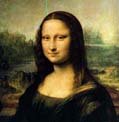
« PREVIOUS ENTRY
To serve and protect

Ever go to the Louvre and wonder how the hell Caravaggio made his faces so crazily lifelike? A controversial book suggests that the Old Masters were quietly getting some technological help on the side. Artist David Hockney has a new book — Secret Knowledge — that claims da Vinci and his contemporaries were using camera obscuras and mirrors to project their real-life subjects onto the canvas, and then simply tracing the images. As CBS reports:
Hockney says it started in Bruges, Belgium, one of Europe’s great 15th century commercial centers, where that optical look, a photographic look, first appeared in the works of Flemish masters like Jan van Eyck.
“[He was] a painter who knew about optical projections and had looked at them,” says Hockney. “One thing the mirror projections do is project surfaces quite amazingly, especially shiny surfaces. And there’s lots of shiny surfaces.”
As Hockney points out, plenty of artists like Leonardo da Vinci were keenly aware of the camera obscura — hell, they practically invented and refined the device. And the “smoking gun,” Hockney argues, is that as soon as Old Masters art became hyperrealistic, there was a profusion of paintings of left-handed people. That would seem to support the idea that the artists were tracing right-handed figures that had been reversed in a camera obscura.
Art critics argue, quite rightly, that there is no written evidence proving Hockney’s theory; no artist of the period has ever discussed using optics and tracing. But there may be a reason for that:
Even today, he says, the artists wouldn’t tell: “They’re very secretive. Remember, they’re competing in business as well.”
It was also the time of the Inquisition, when mirrors and lenses were associated with witchcraft.
“When Caravaggio is painting in Rome, around the corner in the square, they’re burning Claudio Bruni for looking through lenses,” says Hockney.
If you’re intrigued by this, check out an exhibit the New York Institute for the Humanities held in late 2001 to evaluate Hockney’s claims. It’s fascinating stuff, and there’s an archive of other stories that have been written about it here.
Personally, I doubt the tracing thesis, for one simple reason: I simply don’t think the Mona Lisa looks particularly lifelike at all. Truth be told, she creeps the hell out of me. That weird pointy chin. Yeeee.
(Thanks to Plastic for finding this one!)
I'm Clive Thompson, the author of Smarter Than You Think: How Technology is Changing Our Minds for the Better (Penguin Press). You can order the book now at Amazon, Barnes and Noble, Powells, Indiebound, or through your local bookstore! I'm also a contributing writer for the New York Times Magazine and a columnist for Wired magazine. Email is here or ping me via the antiquated form of AOL IM (pomeranian99).

ECHO
Erik Weissengruber
Vespaboy
Terri Senft
Tom Igoe
El Rey Del Art
Morgan Noel
Maura Johnston
Cori Eckert
Heather Gold
Andrew Hearst
Chris Allbritton
Bret Dawson
Michele Tepper
Sharyn November
Gail Jaitin
Barnaby Marshall
Frankly, I'd Rather Not
The Shifted Librarian
Ryan Bigge
Nick Denton
Howard Sherman's Nuggets
Serial Deviant
Ellen McDermott
Jeff Liu
Marc Kelsey
Chris Shieh
Iron Monkey
Diversions
Rob Toole
Donut Rock City
Ross Judson
Idle Words
J-Walk Blog
The Antic Muse
Tribblescape
Little Things
Jeff Heer
Abstract Dynamics
Snark Market
Plastic Bag
Sensory Impact
Incoming Signals
MemeFirst
MemoryCard
Majikthise
Ludonauts
Boing Boing
Slashdot
Atrios
Smart Mobs
Plastic
Ludology.org
The Feature
Gizmodo
game girl
Mindjack
Techdirt Wireless News
Corante Gaming blog
Corante Social Software blog
ECHO
SciTech Daily
Arts and Letters Daily
Textually.org
BlogPulse
Robots.net
Alan Reiter's Wireless Data Weblog
Brad DeLong
Viral Marketing Blog
Gameblogs
Slashdot Games